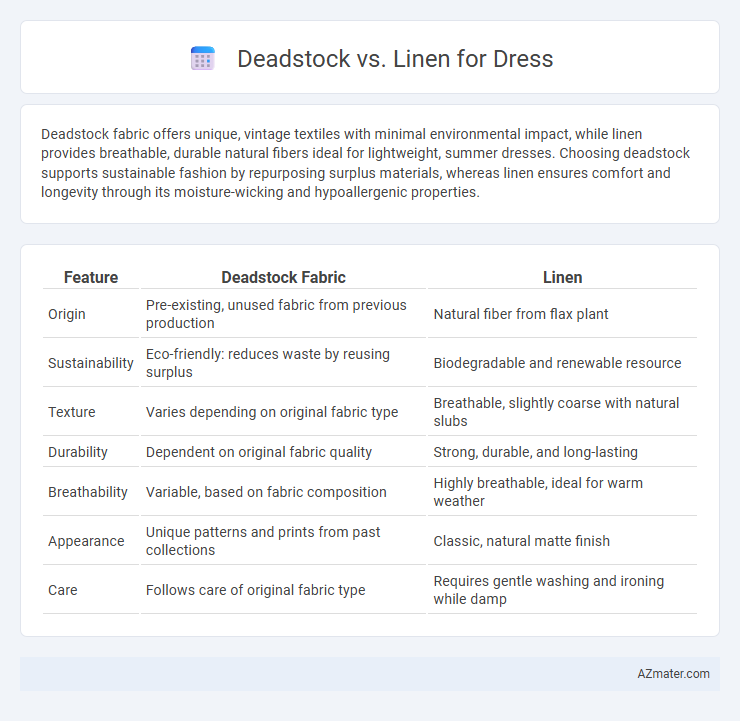Deadstock fabric offers unique, vintage textiles with minimal environmental impact, while linen provides breathable, durable natural fibers ideal for lightweight, summer dresses. Choosing deadstock supports sustainable fashion by repurposing surplus materials, whereas linen ensures comfort and longevity through its moisture-wicking and hypoallergenic properties.
Table of Comparison
| Feature | Deadstock Fabric | Linen |
|---|---|---|
| Origin | Pre-existing, unused fabric from previous production | Natural fiber from flax plant |
| Sustainability | Eco-friendly: reduces waste by reusing surplus | Biodegradable and renewable resource |
| Texture | Varies depending on original fabric type | Breathable, slightly coarse with natural slubs |
| Durability | Dependent on original fabric quality | Strong, durable, and long-lasting |
| Breathability | Variable, based on fabric composition | Highly breathable, ideal for warm weather |
| Appearance | Unique patterns and prints from past collections | Classic, natural matte finish |
| Care | Follows care of original fabric type | Requires gentle washing and ironing while damp |
Understanding Deadstock Fabric
Deadstock fabric refers to unused, surplus textile remnants from previous manufacturing runs, often prized for its sustainable and unique qualities when used in dressmaking. Linen, a natural fiber derived from the flax plant, is renowned for its breathability, durability, and moisture-wicking properties, making it a popular dress fabric. Understanding deadstock fabric involves recognizing its eco-friendly advantage, limited availability, and potential for distinct patterns or textures that can add character to garments.
What is Linen Fabric?
Linen fabric is made from the fibers of the flax plant, known for its durability, breathability, and natural moisture-wicking properties. It offers a lightweight, textured feel ideal for warm-weather dresses, providing a crisp, elegant appearance with excellent airflow. Compared to deadstock fabric, linen emphasizes sustainability through its biodegradable nature and minimal processing while maintaining comfort and style.
Sustainability: Deadstock vs Linen
Deadstock fabric repurposes surplus textiles, reducing landfill waste and minimizing the environmental impact of new material production, making it a sustainable choice for eco-conscious dressmaking. Linen, derived from flax plants, is biodegradable, requires less water, and involves lower pesticide use compared to cotton, contributing to its reputation as an environmentally friendly textile. Choosing between deadstock and linen for dressmaking involves balancing waste reduction through fabric reuse versus sourcing renewable, low-impact natural fibers.
Texture and Comfort Comparison
Deadstock fabric offers a unique texture with a vintage, slightly worn feel that softens over time, providing a distinct character ideal for eco-conscious dress materials. Linen, known for its natural breathability and slightly coarse texture, becomes softer with wear and is highly valued for comfort in warm weather. Comparing comfort, deadstock fabrics vary widely due to their diverse origins, while linen consistently delivers lightweight, moisture-wicking properties essential for all-day wear.
Breathability and Wearability
Deadstock fabric often provides superior breathability due to its natural fibers, allowing better air circulation and moisture absorption, which enhances comfort in dresses. Linen is renowned for its exceptional breathability and lightweight properties, making it ideal for warm climates and prolonged wear without causing overheating. While both materials offer excellent wearability, linen's durability improves with washing, whereas deadstock fabrics may vary in texture and longevity depending on their original production.
Availability of Colors and Patterns
Deadstock fabrics offer limited availability in colors and patterns, often reflecting vintage or unique designs that are no longer in production, making each piece distinctive and rare. Linen fabrics typically come in a wider range of colors and patterns, including solid shades, stripes, and subtle prints, due to their ongoing and large-scale production. Choosing between deadstock and linen for a dress depends on the desired exclusivity and variety in color and pattern options.
Price Points: Which is More Affordable?
Deadstock fabrics often come at lower price points due to their surplus nature and limited availability, making them a cost-effective choice for dressmaking. Linen, known for its natural fibers and breathability, tends to be more expensive because of its production process and durability. Comparing affordability, deadstock typically offers more budget-friendly options, while linen commands a premium price reflecting its quality and longevity.
Durability and Longevity
Deadstock fabrics are typically vintage or leftover materials that have been stored without use, offering unique textures but varying durability depending on their age and storage conditions. Linen, made from flax fibers, is renowned for its strength and breathability, becoming softer and more durable with each wash while maintaining structural integrity over time. Choosing between deadstock and linen depends on desired longevity; linen consistently outperforms deadstock in durability due to its natural fiber properties and resistance to wear.
Ethical Considerations for Conscious Fashion
Deadstock fabric, sourced from unused surplus textile inventory, offers a sustainable choice by reducing waste and limiting the demand for new raw materials in dressmaking. Linen, derived from flax plants, stands out for its natural biodegradability and low water footprint, making it an eco-friendly fabric with a long biodegradable lifecycle. Choosing deadstock or linen dresses supports ethical fashion by promoting resource conservation, minimizing environmental impact, and encouraging responsible production practices.
Which is Better for Dressmaking?
Deadstock fabric offers unique, often vintage materials that bring exclusive patterns and textures to dressmaking, providing sustainability by repurposing unused textiles. Linen, renowned for its breathability, durability, and natural luster, is ideal for lightweight, comfortable dresses suitable for warm climates. Choosing between deadstock and linen depends on the desired aesthetic, environmental values, and fabric performance, with deadstock excelling in uniqueness and eco-friendliness, while linen excels in comfort and longevity.

Infographic: Deadstock vs Linen for Dress
 azmater.com
azmater.com